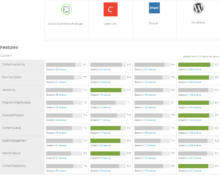
You know your business is going places, but does your website communicate that in multiple languages? When the time comes to translate your site into different languages, you need to know which multilingual content management system (CMS) is right for you. Choosing the right CMS for your multilingual website is crucial for effective CMS translation and seamless content management across different languages. There are many particulars you should consider when choosing a multilingual CMS.
Localization considerations for a multi-language CMS
Taking your website global isn’t easy. There are many hurdles and potential roadblocks that can slow progress if you’re not clear about what you need. To find the best multilingual CMS for your business, start by considering if it works with your business needs. Do you need internationally friendly forms or time zone-aware scheduling? Will your data be stored safely once it’s translated? Was the CMS designed with translation/localization/internationalization in mind so updates are easily scalable?
Unless you’re a tech wiz or familiar with some of these aspects, you may not have the answers — but that’s why we’re here. Simplify your search for a good multilingual CMS by looking for the following features:
Global site architecture
The system should generate country sites easily and designate what needs to be translated, whether that’s regionally or globally. Your website is key to your international growth strategy, so we created “The Insiders Guide to Creating a Multilingual Website.” Let us walk you through the process!
Translation workflow
You should be able to initiate the translation process on-demand and in scheduled batches. But you wouldn’t want this content to go live without knowing it’s accurate. That’s where pseudolocalization, staging sites, and in-CMS testing come into play. With these efforts, you can verify and test the result of this process before translation begins.
Multilingual content management
You’ve spent a great deal of time creating your brand, and when you go global, you’ll want that to show with quality translations and enhanced collaboration. Multilingual content management ensures you maintain a unified brand message across all translated content. With complete unicode support, the CMS will display, edit, and manipulate any language accurately while supporting all characters from every language (especially Arabic, Japanese, and Russian). What’s more, a localization-ready CMS improves collaboration among team members with scalable edits and updates across languages, even for the smallest web or marketing teams.
API integration or CMS translation connector
Your multi-language CMS should save you time and eliminate manual handoffs for localization. It should be built to allow you and your translation partner to easily pull and push web content automatically via an application programming interface (API) integration or CMS connector without having to resort to copying and pasting or exporting and importing source and translated content.
To make your quest for the right multilingual content management system a little easier, we’ve compiled a list of the top open-source and proprietary systems worth considering.
Many companies find that an open-source CMS suits their translation needs because the source code is freely available and may be redistributed and modified. There are many benefits found in the top platforms. Here’s how to choose the best CMS for your business:
Open source CMS platforms for multilingual website translation
Many companies find that an open-source CMS suits their needs because the source code is freely available and may be redistributed and modified. If this sounds up your alley, here are some of the benefits of the top platforms:
WordPress
WordPress powers over 32% of the web because of its responsive, mobile‑friendly themes and built‑in optimization. A multilingual WordPress plugin enables you to translate posts, pages, tags, categories, and themes into as many languages as you like. One of the most widely used multilingual plugins is WPML, which web admins can install easily without coding. Check with your translation partner to see if they offer an integration with WPML, enabling you to initiate, manage, and receive translations from within WordPress. To learn more, check out our guide on how to build a multilingual WordPress website.
Drupal
If you need to manage large-scale multilingual sites, Drupal is a good option. With excellent standard features like reliable performance, stellar security, and easy content creation, it’s touted as the best multilingual CMS for translating and managing large-scale sites. But what sets it apart is its flexibility, with tools that help you build a dynamic website with versatile, structured content. Drupal’s translation management tool (TMGMT) enables users to streamline translation workflows. With direct integrations available to language service providers like Acclaro, launching and maintaining a multilingual Drupal site becomes more efficient and cost-effective.
Craft CMS
Pixel & Tonic’s Craft CMS is geared toward development-oriented publishers who want deeper control and more powerful performance from their content management tools. Known for its flexibility, scalability, and user-friendly interface, Craft CMS is ideal for creating custom digital experiences on the web and beyond. Craft CMS is also a hybrid CMS, meaning you can combine monolithic and headless CMS features when building your front end. To eliminate copy and paste, you can launch and manage a multilingual Craft site more quickly and efficiently using the Translation plugin for Craft and automate your translation workflows even further with a translation API.
Adobe Experience Manager (AEM)
Although not an open-source platform per se, AEM is a popular choice among some of the biggest brands that prioritize translation and localization. The platform simplifies managing and delivering a website’s content and digital assets and reduces the complications of delivering virtual experiences to the right customers. To launch and maintain multilingual AEM content more efficiently, we recommend working with a translation agency that offers an AEM translation integration.

*Based on G2 Crowd Reviews
Headless CMS for Multilingual Content Management
Contentful
Contentful’s app framework is built for users who want to control content from a single hub. It integrates hundreds of tools, building digital-first experiences at scale. It has some open-source components, like its field editor libraries, which give it a certain amount of flexibility. As a headless CMS, Contentful’s back-end-only system allows users to access content and reuse it across channels. Contentful users who work in multiple languages can also take advantage of the Translations by Acclaro app to help streamline translation workflows. Our app’s user-friendly interface provides an efficient way to create, review, approve, and publish translated content from within Contentful.
Custom Content Management Systems
If your company has plenty of development resources and IT support, you might want to consider developing a custom CMS, especially if you want to control the platform’s functionality, interface, and updates. A custom solution allows you to tailor content and all of its translations and modifications specifically to suit your business or departmental needs, which will speed up the execution of updates or marketing campaigns. Other benefits include more control over brand consistency, less risk of hacking or spamming, and more personalized support.
When evaluating whether a custom solution is right for you, consider your website and CMS localization needs.
eCommerce CMS platforms
Do you sell products or services on your website? Whether you’re a small mom-and-pop shop or a large corporation, you may want to consider an ecommerce CMS platform or ecommerce plugin for your content management system. Many businesses use enterprise ecommerce platforms like Magento, Shopify, Salesforce Commerce Cloud, SAP Hybris, Sitecore, and BigCommerce, which are already internationalized and localization-ready, meaning they’re set up to handle multilingual product content and different currencies. Choosing the right eCommerce platform will help optimize your customer experience, leading to a more successful global business expansion.
Go far with an experienced translation agency
The ideal multilingual content management system ultimately depends on your company’s translation needs, budget, development resources, and IT infrastructure. No matter which option you pick, partnering with an experienced language vendor is essential. Acclaro can take you where you need to go, with expert website localization in more than 125 languages.
As a tech-independent company, we help you choose the right tools. We can even help you install and configure our CMS translation integrations for WordPress, Drupal, AEM, and Craft CMS, or get started with our Acclaro API. We’re here to give you guidance and support to help you select the best CMS. We can achieve your global business goals together!
If you’re not sure exactly what you need, contact us today for a consultation. Our experts can help you choose the CMS that’s right for you.
Insights for global growth







Power your strategic growth
Go beyond tactical localization with tailored, strategic solutions that resonate locally and drive growth globally.
Get started